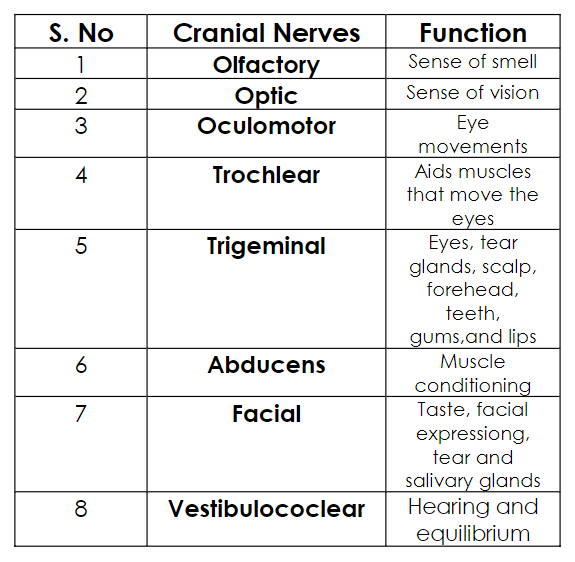Biology: Nervous System
Nervous System
It is important in helping to maintain the homeostasis(balance) of the human body
It is a series of sensory receptors work with the nervous system to provide information about changes in both the internal and external environments
The human nervous system is a complex of interconnected systems in which larger systems are comprised of smaller subsystems each of which have specific structures with specific functions.
Structure and Function
Neurons – They are also called nerve cells. These are the basic elements of the nervous system.
Cell Body: The main processing center of the cell.
Dendrites: Thin branching extensions of the cell body that conduct nerve impulses toward the cell body
Axon: A single branch which conducts nerve impulses away from the cell body. Myelin sheath and neurilemmal are coverings.
Impulse Transmission
Terminal end fibers are located at the ends of the axon and they transmit impulses leaving the neuron across a synapse to the next neuron.
Three Types of Neurons
Efferent(Motor) – Conveys information from the CNS to muscles and glands.
Afferent (Sensory) – Carry information from the sensory receptors to the CNS.
Interneuron – Carry and process sensory information.
Neuroglia – Support, protect, connect, and remove debris from the nervous system.
Types of Neuroglial Cells
Astrocytes
Oligodendroglia
Microglia
Two Major Components
Central Nervous System (CNS)
Made up of the brain and the spinal cord
Peripheral Nervous System (PNS)
Made up of all the nerves that lead into and out of the CNS.
Central Nervous System
The central nervous system is composed of two major interconnected organs: The brain and the spinal cord
These organs work together to integrate and coordinate sensory and motor information for the purpose of controlling the various tissues, organs, and organ systems of the body.
It is responsible for higher neural functions such as memory, learning, and emotion.
Brain: it weighs 3 pounds in adults. It is 75% water and 20% oxygen. It contains over 100 billion neurons. It controls bodily functions and interactions with the outside world
Four Parts of the Brain
Cerebrum
Diencephalons
Brain Stem
Cerebellum
Brain Stem****: Made up of the midbrain; Pons and the medulla oblongata.
Midbrain****: Involved with the visual reflexes.
Pons: Located between the midbrain and the medulla oblongata. It controls certain respiratory functions.
Medulla Oblongata****: Contains centers that regulate heart and lung functioning, swallowing, coughing, vomiting, and sneezing.
Cerebellum
Area that coordinates musculoskeletal movement to maintain posture, balance, and muscle tone.
It is inferior to the occipital lobes of the cerebrum. It is posterior to the pons and medulla oblongata.
Cerebrum
It is located above the cerebellum. It contains two hemispheres with an outer portion called cerebral cortex.
The two hemispheres are connected by a bridge of nerve fibers that relay information between the two hemispheres called the corpus callosum.
The left and right lobes are each divided into four lobes or parts: Parietal lobe, Frontal Lobe, Temporal Lobe, Occipital Lobe.
Diencephalon
The deep portion of the brain containing: Thalamus, Hypothalamus, Epithalamus, Ventral thalamus.
It serves as relay center for sensations like: Heart rate, blood pressure, temperature control, behavioral response, digestive functions, water and electrolyte balance.
Spinal Cord
It extends from the medulla oblongata of the brain to the area around the first lumbar vertebra in the lower back.
The nerves from the peripheral nervous system extend out from the spinal cord.
It is protected by vertebral column, cerebrospinal fluid, meninges.
Meninges are three layers of membranes that cover the brain and spinal cord.
Layers of the Meninges
Dura Mater: Outer tough fibrous membrane
Arachnoid Mater; Middle web like membrain containing CSF.
Pia Mater: Innermost layer containing several blood vessels.
Peripheral Nervous System
It is a collection of peripheral, nerves, ganglia and specialized sensory structures that, as a system, carries sensory and motor information between the central nervous system and all other organs and tissues of the body.
The peripheral nervous system is functionally divided into two major divisions: The Sensory or Afferent Division, The Motor or Efferent Division.
It contains 12 pairs of cranial nerves and 31 pairs of spinal nerves


Somatic Nervous System
Responsible for receiving and processing sensory input from the skin, muscles, tendons, joints, eyes, tongue, nose and ears as well as excite the voluntary contraction of skeletal muscles
Autonomic Nervous System
It carries impulses from the central nervous system to glands, various smooth muscles, cardiac muscle, and various membranes
It stimulates organs, glands, and senses.
 Knowt
Knowt
